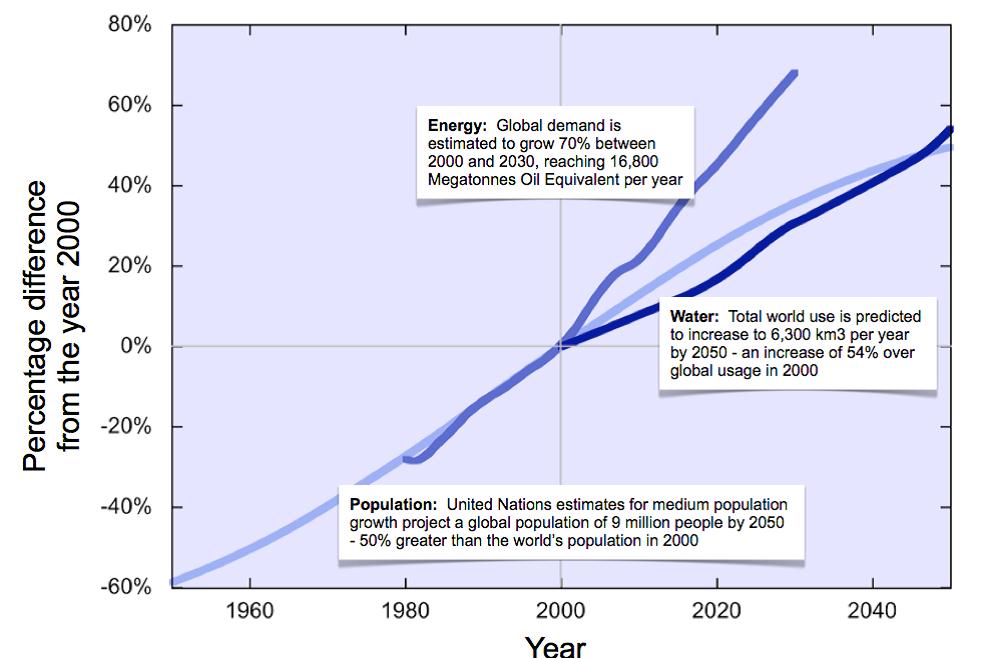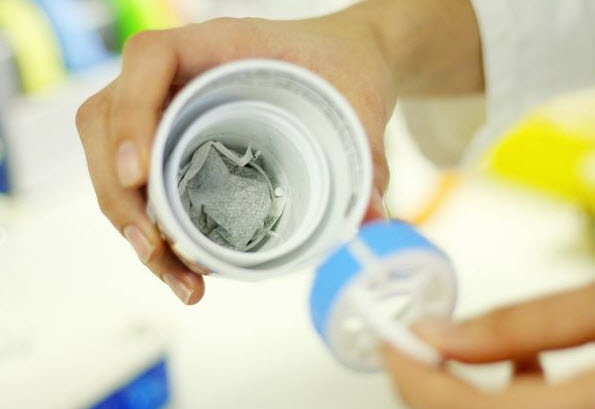Water crisis: nano solutions
UCSB researcher with scanning-tunneling electron microscope.
The risks to our global water supplies are many and complex. They include aquifer depletion from excessive withdrawal; increases in salinity from saltwater incursion, irrigation practices, fertilizer use, and road salting; pollution from industrial, agricultural, and human and animal waste; and drought exacerbated by climate change. As our usable water supplies are diminishing, population growth, energy use, and economic expansion are combining to increase stress on this resource.
The decline in quality and quantity of fresh water, combined with increased competition among resource-intensive systems, such as food and energy production, is resulting in a water supply crisis. The 2013 World Economic Forum Global Risks Report[i] identified this water supply crisis as one of the top five risks in both likelihood of occurrence and severity of impact on society over the next 10 years. The risks “underscore the need for technological innovation to transform the way we treat, distribute, use, and reuse water toward a distributed, differential water treatment and reuse paradigm (i.e., treat water and wastewater locally only to the required level dictated by the intended use).”[ii]
Estimates by the United Nations suggest that by 2050 the global population will increase to 9 billion, 50% greater than the population in 2010 (Figure 1), and that by 2025 nearly half of the world’s population will be living in megacities, which will not necessarily be located in areas of renewable or sustainable water supply.[iii] To meet the challenges in an ever more resource-challenged world, innovation and technology must play an increasing role. Nanotechnology, the engineering of matter at the atomic scale to create materials with unique properties and capabilities, will play a significant part in ensuring that risks to critical water resources for future cities are addressed. Nanotechnology “has the potential to be a key element in providing effective, environmentally sustainable solutions for supplying potable water for human use and clean water for agricultural and industrial uses.”[iv]
Scientists are now able to engineer and create nanomaterials to take advantage of specific properties not present in their bulk counterparts. For example, the large surface areas of some nanomaterials, like nano metal oxides and nano fibers, have enhanced capacities to absorb contaminants; nanosilver is being used in commercially-available point-of-use water treatment devices as an antimicrobial and antifouling agent.
Emerging Organic Contaminants (EOCs) have proved particularly difficult to remove from drinking water and industrial, agricultural, and municipal waste streams. EOCs include synthetic organic chemicals such as pharmaceuticals, personal care products, plasticizers and flame retardants. Many of these chemicals are endocrine disruptors that are biologically active and can potentially cause adverse ecological and human health effects.
One of AECOM’s research partners, Dr. Arturo Keller, Professor of Biogeochemistry at the Bren School of Environmental Science and Management, University of California-Santa Barbara, recently published a paper called Magnetic Nanoparticle Adsorbents for Emerging Organic Contaminants.[v] The study concludes that the low energy and relatively low cost to synthesize magnetic nanoparticles, the ease of recovery from points of application with a magnetic field, and their regenerability make magnetic nanoparticles a more sustainable option than traditional approaches for removing emerging organic contaminants from contaminated waters such as granular activated carbon or oxidation.
Nanotechnology-based approaches may help provide quality water while reducing the requirement to replace the aging large-scale water treatment infrastructure in existing cities or construction of new large-scale infrastructure in new cities.
One approach AECOM is evaluating for use in wastewater and groundwater treatment was developed by AquaNano, a start-up with ties to Caltech. AquaNano’s treatment technology uses dendrimers, a type of nano-scaled polymer that can be engineered to sequester specific chemicals. The resulting effluent is free of contaminants and can be released or reused. The sequestered chemicals can be recovered and the dendrimers can be reused.
AECOM has also established a collaboration agreement with Stellenbosch University in South Africa to evaluate a unique water treatment device they have developed in which the nano-enabled treatment media are placed in common tea bags. As water passes through the bag, contaminants are absorbed by carbon while the nanofiber biocides destroy microorganisms. This simple, practical product makes contaminated water safe to drink – quickly and inexpensively. This application is associated with the University’s Hope Project. AECOM originally viewed this application as a way to provide clean water to those most in need in developing countries, but it has the potential for scale-up to use by larger populations in the developed and developing world.
Stellenbosch University’s (South Africa) Hope Project’s nano-enabled water purification device provides a sustainable solution to solve water related challenges. From http://thehopeproject.co.za/hope/projects/academic/water/Pages/About.aspx
I believe that using new sustainable, nano-enabled water treatment technologies currently under development, in concert with other initiatives, will ensure the future availability of water resources for our world.
[i] Lee Howell, Ed. in Chief, World Economic Forum, Global Risks 2013 – Eighth Edition, 2013,
[ii] X. Qu, J. Brame, Q. LiI, and P. J. J. Alvarez, Nanotechnology for a Safe and Sustainable Water Supply: Enabling Integrated Water Treatment and Reuse. Accounts of Chemical Research, Vol. 46, No. 3, 2013 , pg. 834, 06/27/2012,
[iii] D. Lui, I. Rowbottom and L. Vandeventer, At risk: the world’s water supply, AECOM Global Perspectives – Meeting global challenges, p. 4, 2007
[iv] M. Roco, C. Mirkin, M. Hersam, Eds, Nanotechnology Research Directions for Societal Needs in 2020: Retrospective and Outlook Chap 5: Nanotechnology for Sustainability: Environment, 150 Water, Food, and Climate pg 150, 10/2010
[v] Yuxiong Huang and Arturo A. Keller, Magnetic Nanoparticle Adsorbents for Emerging Organic Contaminants, Sustainable Chemistry and Engineering, pg 736, 5/14/2013









